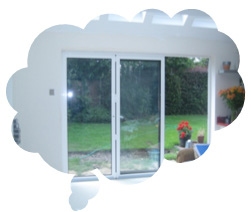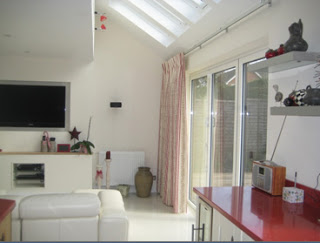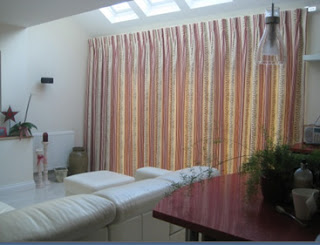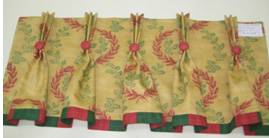Sharon Kearney had read every curtain making book she could find, but wanted to take her skills to the next level. She enrolled on a Professional Soft Furnishings and Curtain Making diploma course at The National Design Academy, where she teamed up with old friend and fellow student Debbie.
The two decided to take the plunge and set up their own business, Grasshoppers Interiors. Two years on, the business is flying and team Grasshopper is still going strong. Put your feet up and enjoy Sharon and Debbie’s story of success.
You had already been making curtains for friends and family before you started the NDA’s Diploma in Professional Curtain making and Soft furnishings, what made you want to take up the course?
Over the years most of my knowledge about curtain making and soft furnishings had come from reading curtain making books – I think I must have read every book ever published on the subject! I did have a lot of experience making things for family and friends, but I now was planning to set up a business – with customers paying real money for my services. I wanted to be sure that the quality of my work was of a professional standard.Taking up the course was as much about giving me the confidence as it was about learning the different aspects of professional curtain making and soft furnishings.
How did you find the distance learning experience and would you recommend it to others?
Studying through distance learning was the ideal solution for me as I was establishing the business, looking after my six year old son and studying all at the same time. It meant that I could study the course work at a time and place that suited me and complete my assignments in the evenings or weekends. I also attended practical courses at a local workroom where I was able to get hands-on experience, advice and encouragement from an established professional curtain maker.
Finding the time to set aside to concentrate on your study can be very difficult, how did you discipline yourself and get into the study zone?
I really enjoy learning all the technicalities about the craft of soft furnishings. I find it fascinating and am often on the web reading curtain making forums. Studying the course notes didn’t really feel like a burden – it was fun – so I made time. I would take a small section at a time out of the binder and take it with me in my bag. Then if I was given a chance to read, such as in the dentist’s waiting room, out it would come. Completing the assignments a little bit at a time meant I tended to avoid hurrying (and worrying) to get it done by the due date.
What are your three golden rules when faced with a client brief?
1. Ask lots of questions – to get the bigger picture.
When designing and making window treatments there are lots of factors that need to be taken into consideration – important information that the client doesn’t necessarily know to volunteer. Usually our first question is – What do you have in mind? This gives us the basis. Then we ask lots of additional questions to fill in the gaps, such as – How is the room used? How much light is there? What are the largest areas of colour in the room such as walls, large furniture items? What styles do the client’s prefer? Is anything likely to be changing – e.g. flooring, furniture? Etc. Although we are primarily designing and making soft furnishings we often provide interior design advice to try to ensure the best result for the client.
2. Listen carefully – to make sure we understand the client’s needs and expectations.
It’s very easy to make assumptions about what the client might want or what we ourselves might prefer, so we are careful to listen and make notes about the clients’ preferences and their expectations. After all, they need something that will fit with their lifestyle and they will continue to like for many years. It’s not very practical to suggest luxury silk puddle curtains with small children running around. We record this information on our Client Brief form.
3. Offer options – to give a few different solutions/proposals for the client to contemplate
We usually make suggestions and offer options with their pros and cons – rather than provide and outright solutions. That way the client is involved in the thinking process and decision making becomes easier. For example if a client is thinking about a roller blind in a bedroom we will often ask if they have considered a Roman blinds as this gives a softer more dressed look to the window.
Your business partner also studied the same course at The National Design Academy, how did you both decide that it would be good to work together and how is the partnership still going strong?
Debbie and I worked for a large corporate company for many years and planned and discussed our own interiors and soft furnishings over coffee. We often talked ‘tongue in cheek’ about setting up our own interiors business, specialising in hand crafted soft furnishings. We also liked the idea of being responsible for our own destiny and the ability to create a better work life balance. So, when the opportunity presented itself – we both jumped at the chance to make it happen. We were really pleased with the speed that orders came in, and still come in two years later.
Making the transition from study to setting up a business can be tricky, how did you start the ball rolling and what advice would you give to others who want to do the same.
We had the usual doubts and trepidation when embarking on something new – especially in such uncertain economic times. In early spring 2009 we decided to learn as much as we could and just get on with it. These are some of the things we did that we would recommend:
- we started studying, attended local curtain making courses and joined Internet curtain making forums to learn as much as we could
- we Googled images for ‘curtain’ and ‘drapery’ workrooms to get ideas for creating a good workroom
- we invested in some fabric books and all the basic sewing equipment we would need
- we opened an account with a web hosting company which gave us our business email account and the tools to build our own website and photo portfolio – for only £5 per month
- we researched and created an initial pricing structure by looking at other supplier
- we invested in ACE For Windows, a computerised curtain estimating package to enable us to quickly record customer details, print quotes, calculate fabric quantities, and invoice our clients.
- we purchased an ‘A’ Board for advertising as we on a busy road
In August, we invited all our family, friends to an opening party. We started with a few orders, and as they say, ‘the rest is history’. It was a steep learning curve but great fun and we continue to learn and develop all the time.
Where does your inspiration come from when you’re designing new furnishings?
Inspiration initially is linked to our clients needs. This may be a client’s favourite colour, a piece of furniture, a rug, a preference for a certain style. Then there are the practicalities to consider. How the soft furnishings will be used. For example if a number of roman blinds are to be used in a room we recommend a rotary mechanism rather than cord and cleat – perhaps even with a mechanised system. Over and above the ‘design’ inspiration is helped by many things, reading home magazines, attending trade shows, images on the Internet – particularly hotels. As time has gone by we gain inspiration though our own experience of visiting many different homes.
Can you pick out the best project you’ve completed and what made it so successful?
One that immediately springs to mind is a recent project for a huge kitchen/TV room with a four metre patio door. There was a large expanse of wall to the left of the doors and literally no wall the other side – where the kitchen units began. The doors also folded back to the left hand side – making a pair of curtains impractical.
We made one long seven-width interlined curtain which would stack back over the left hand wall. The size was quite a challenge requiring careful fabric management on our 150cm wide worktable.
Our client had chosen one of our favourite Baker Lifestyle fabrics, with alternating stripes and embroidered leaves. We pleated the curtain ‘by design’, positioning the pleats so that they alternated between the stripe and the leaf design. We also deliberately positioned a red stripe along the leading and back edges to ‘finish’ the edges.
We enjoy adding value by caring about this sort of detail. We believe this is what makes hand crafted curtains a worthwhile investment. The room looked stunning and our client was really pleased and said the result far exceeded her expectations. That’s success for us!
Would you recommend the NDA’s Diploma in Professional Curtain making and Soft Furnishings to others?
Yes definitely. It takes you through the construction methods of most examples of soft furnishings such as interlined curtains, soft valances, pelmets, swags and tails etc. The information towards the end of the course material also has lots of practical advice about establishing a soft furnishing business, such as identifying trade suppliers. It helped us to know how to initially apply for trade accounts on a proforma basis (payment up front) which doesn’t necessarily rely on having other trade references.
What does the future hold for Grasshoppers Interiors?
Every job provides a different set of challenges and every day provides a different opportunity to practice our craft. We are continually delighted by the high number of repeat customers we have. It is really satisfying to build a long term relationship with our clients as we become involved in the ongoing decoration of their homes. We aim to continue to build our reputation for a personal service and high quality yet affordable custom soft furnishings.
Visit Grasshoppers blog: http://grasshoppersinteriors.blogspot.com/
Or you can visit their facebook page for more exciting news






2 responses
I have read your blog, I FEEL REALLY INSPIRED by your sheer determination to make the business work. I’m in the process of doing the same thing with a friend. If you have any tips please pass them on.
Joni
I have been trying to get my businessof the ground since 2015, it seems I have hit a quite moment for my 2nd year what should I do
Thank you